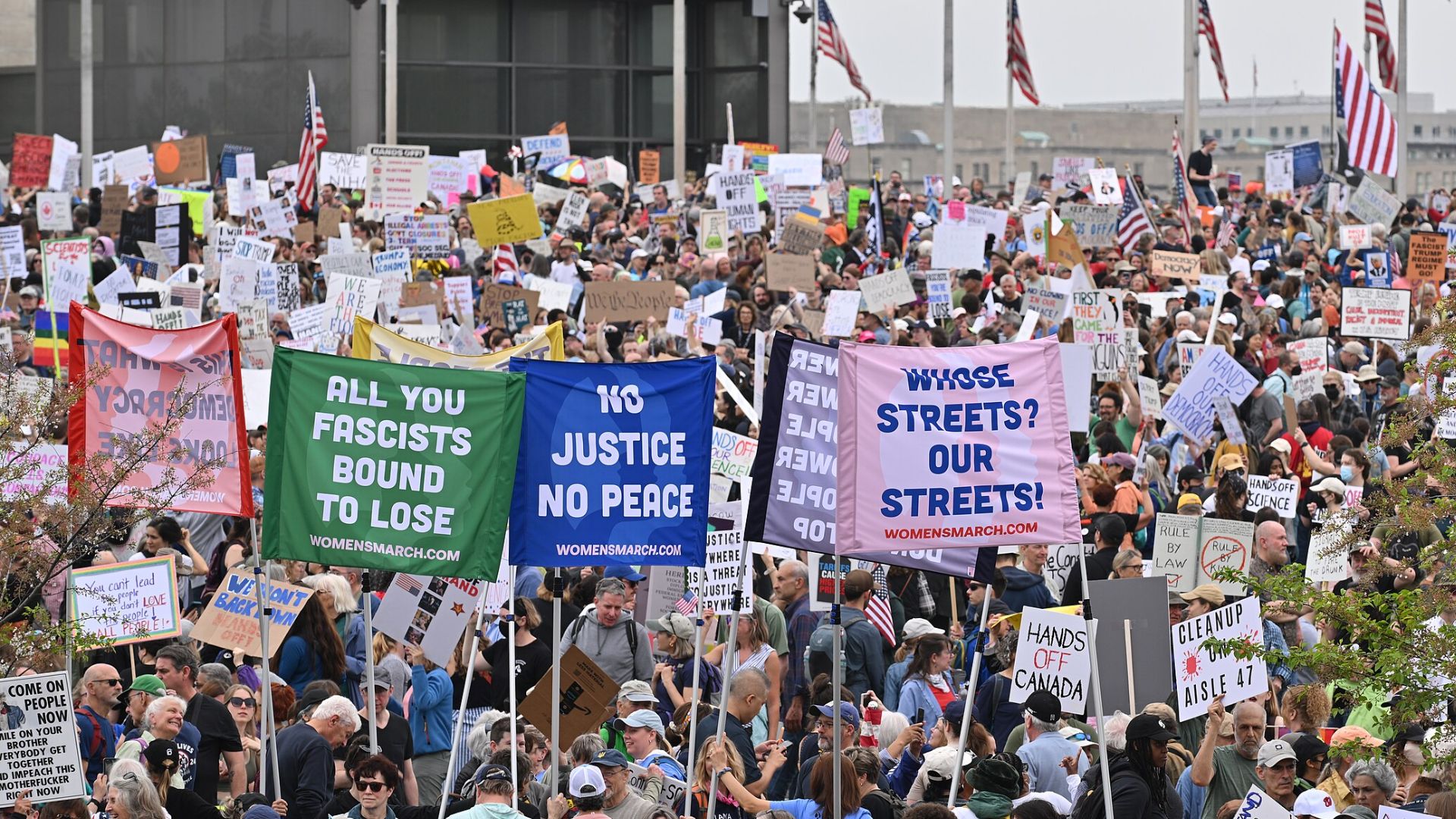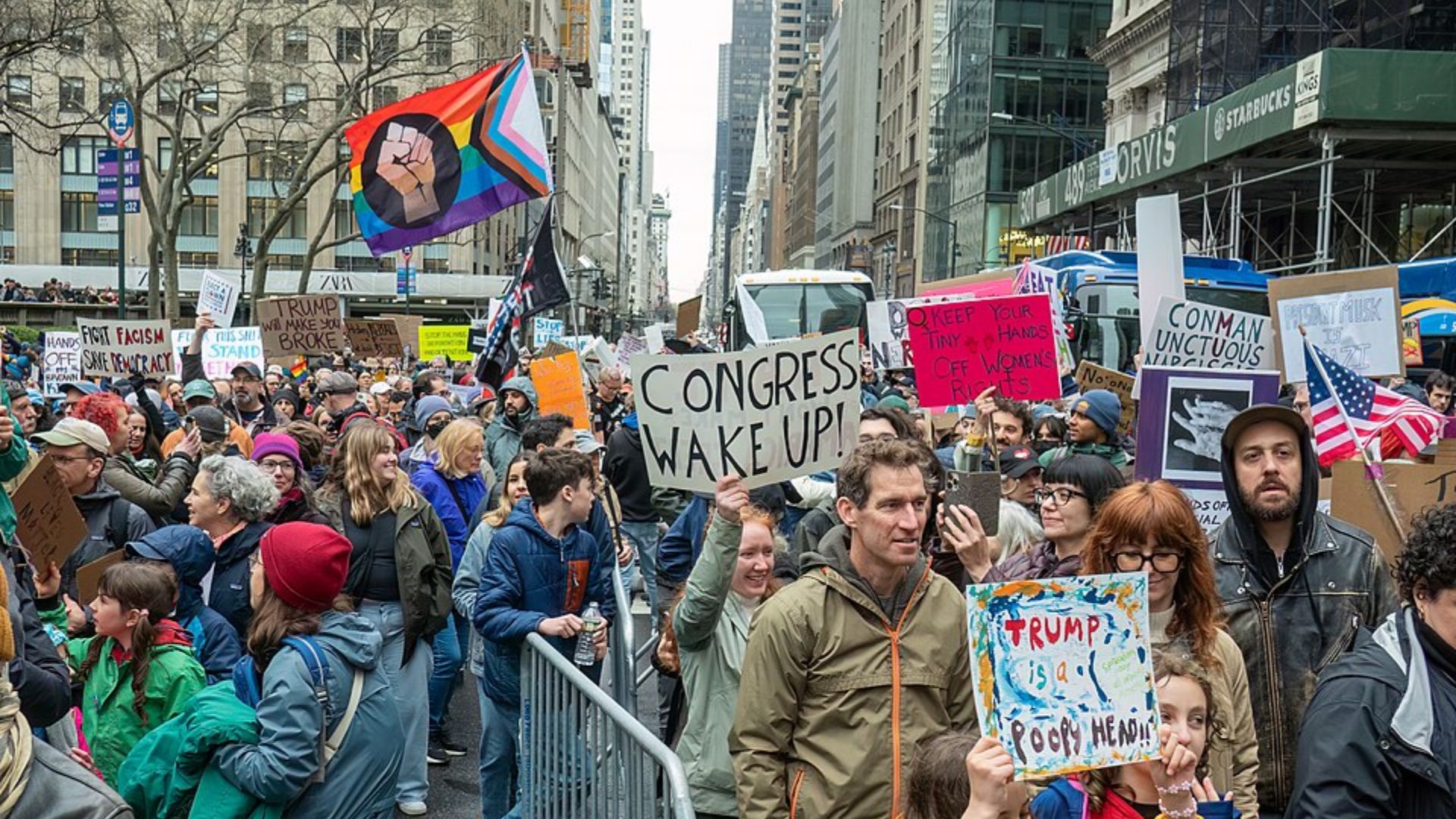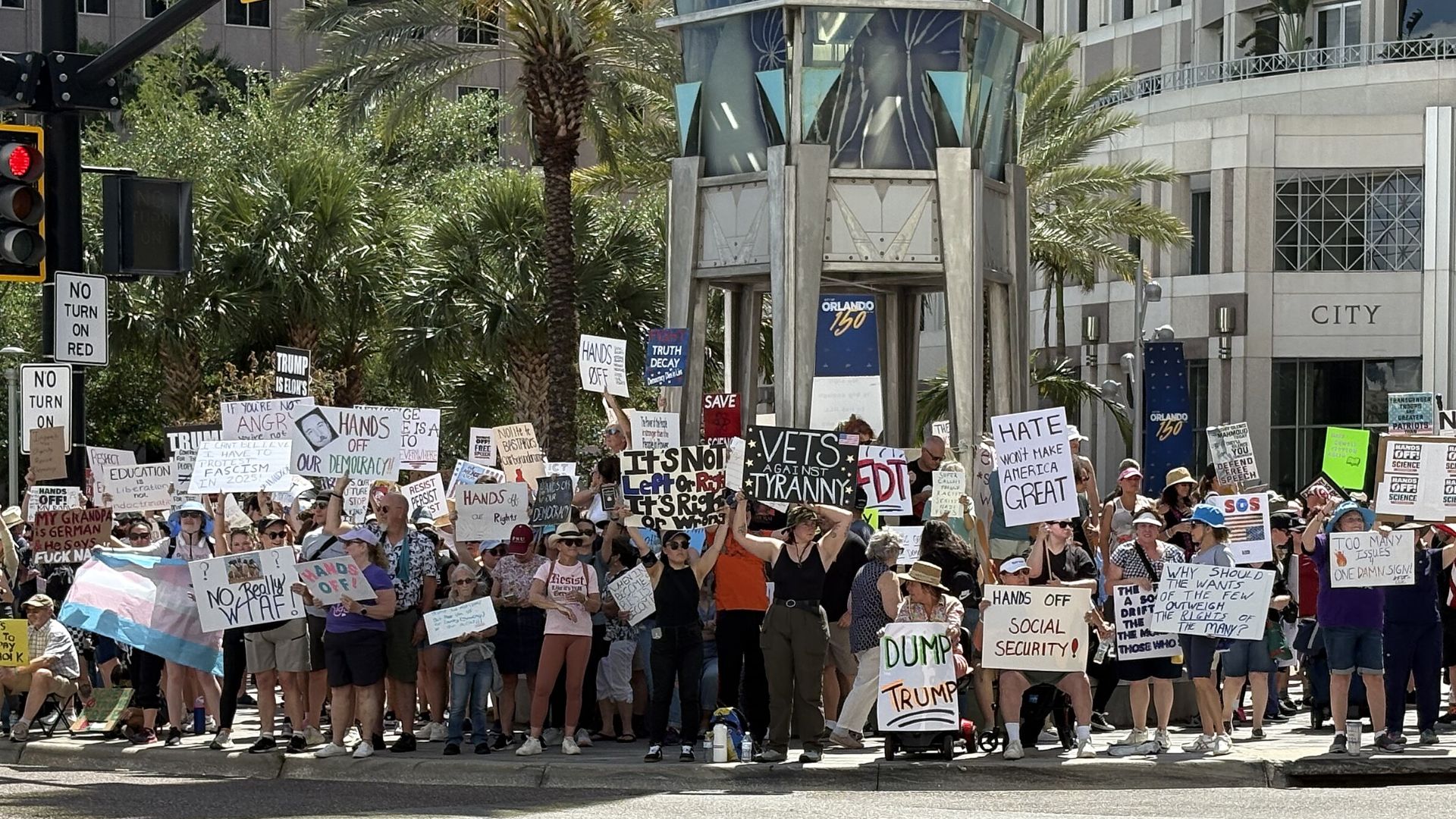In the first hundred days of the Trump presidency, opposition in the streets grew from hundreds to millions. The previous Strike! Commentary, “Social Self-Defense Has Begun,” traces the early stages of the resistance to Trump’s MAGA autocracy. This commentary describes two large national days of action, Hands Off! And Mayday, and evaluates the development of the movement so far.

Hands Off, National Day of Action, Saturday April 5, 2025. Rally by the Washington Monument in Washington, DC. | Photo credit: G. Edward Johnson, Wikipedia Commons, CC By-SA 4.0
Hands Off!
On March 14, Indivisible, MoveOn, the Working Families Party, 50501, and other groups announced nationwide “Hands Off!” demonstrations for April 5. According to an interview in Rolling Stone with Indivisible co-founder Ezra Levine, the initiators included “groups that rose to prominence in the first Trump administration, like Indivisible, upstarts like the 50501 movement, as well as established grassroots groups like MoveOn.” Unions, civil rights organizations, and other grassroots groups joined. “It became a big love fest in the pro-democracy, progressive organizing, grassroots space. Everybody was pushing out to their members to try to spread it as wide as possible.” In less than a week they had 400 events registered.
The Hands Off! Toolkit framed the action thus:
Donald Trump has launched an unprecedented power grab—driving up prices, slashing funding for essential programs, and creating instability at every turn. Enabled by Elon Musk and Republicans in Congress, his corrupt agenda is making life harder for everyday Americans while eroding our democracy.
Trump and his allies are rapidly stripping America for parts and selling us out—and now Congress is trying to do the same by slashing Medicaid, Social Security, cancer research funding, and more. Why? To give more tax cuts to billionaires.
This administration is targeting everybody who isn’t part of the 1%—veterans, kids, seniors, farmers, immigrants, transgender people, and political opponents. All to consolidate power and reward their allies.
The Toolkit called for
massive, visible, national rejection of this crisis. On April 5, we will host events across the country, in major cities and small towns in every state. Our goal is to show that the people—the majority—are taking action to stop the corruption and power grab.
With only three weeks organizing, well over two million people joined more than 1,400 local Hands Off! actions at state capitols, federal buildings, congressional offices, Social Security headquarters, parks, and city halls. CNN described the actions as “protests against President Donald Trump and Elon Musk across all 50 states and globally,” organized by “a pro-democracy movement” in response to what they call a “hostile takeover” and “attack on American rights and freedoms.” A flyer for the event said,
Whether you are mobilized by the attacks on our democracy, the slashing of jobs, the invasion of privacy, or the assault on our services – this moment is for you. We are setting out to build a massive, visible, national rejection of this crisis.
A variety of individuals and groups served as “hosts” for local Hands Off! actions. The web technology platform Mobilize provided rapidly updated information on local events, hosts, and registered participants. Partner organizations provided toolkits, on-line trainings, and the opportunity to consult with experienced organizers as needed. Thousands of local activists participated in frequent on-line meetings.
While it is clear that millions participated in Hands Off! events on April 5, there is limited information on their locations and demographics. Business Insider sent reporters to cover many local Hands Off! actions. In New York they reported, “The crowd looked older, with middle-aged Americans seeming to outnumber the 20-somethings that dominated rallies during the pandemic. Similarly, in San Francisco “Older millennials and seniors made up large swaths of the crowd.” At a large demonstration in Novi, MI they found that “Many attendees said they were first-time protesters” and that “Unlike protests during Trump’s first term, which focused on social issues,” many people at the Hands Off! actions “were also worried about the president’s economic policies.”
The millions who participated in the Hands Off! day of action exemplify the defense of society against the MAGA assault. They represent what I have called Social Self-Defense.
May Day
May Day Protest Against Trump in San Francisco (May 1, 2025) | Video credit: CatSynth TV
For a century and a half, the first of May has been celebrated by the labor movement worldwide as International Workers Day. With the anti-Communist orientation of most US unions, participation in May Day celebrations was long anathema to all but the left margin of organized labor in the US. On May Day, 2006, millions of immigrants and supporters, with wide union backing, joined marches and demonstrations around the country protesting anti-immigrant legislation. In 2012 Occupy Wall Street called for a national May Day general strike, with many resulting local demonstrations but little in the way of strikes. In more normal times, May Day has been the occasion for small local gatherings of self-defined leftists and a few union progressives.
In March 2025 a gathering at the Chicago Teachers Union brought together more than 250 people from 26 states, plus others who joined virtually. According to Jackson Potter, vice-president of the CTU, it included members of large locals in the AFT, NEA, AAUP, British Columbia Teachers Federation, UNITE HERE, AFGE, United Auto Workers, SEIU and dozens of other labor unions, as well as community organizations like Make The Road, State Voices, Center for Popular Democracy, Mijente, and Showing Up for Racial Justice. Potter noted,
For many of the organizations involved with May Day mobilizations, this is the first time we are working outside of our union sector or region, and alongside federal government and private sector locals, with the participation of national community networks and their local affiliates.
A May Day Strong coalition of over 200 organizations included the Chicago Teachers Union, National Education Association, American Federation of Teachers, Communication Workers of America, Association of Flight Attendants-CWA and United Electrical Workers, as well as the Sunrise Movement, the Center for Popular Democracy, Indivisible, and other issue-based organizations, from Palestine organizing to reproductive justice to immigrant rights.
The May Day preparations included many of the groups that had partnered for Hands Off! The initiative had a dual character, reflecting the two streams that flowed together to form it. Like Hands Off!, it emphasized MAGA’s destruction of democracy and its devastating impacts on ordinary people. And like progressive trade unionists, it used the language of class to emphasize Trump’s actions as an assault by the wealthy on the working class and to proclaim the critical role of workers and unions in resisting it. The May Day call asserted,
Trump and his billionaire profiteers are trying to create a race to the bottom—on wages, on benefits, on dignity itself. This May Day we are fighting back. We are demanding a country that puts our families over their fortunes—public schools over private profits, healthcare over hedge funds, prosperity over free market politics.
On a planning call for the day of action Omar Lopez, a longtime organizer with Chicago’s Immigrant Defense Resistance Council, said,
We are powerful because we are workers. Our power comes from the work we do in the restaurant industry, in agriculture, in construction, in gardening and in other industries. Without us, the economy of this country will collapse. Being a worker is having power.
Over the ensuing month, partner organizations reached out to their members and local groups to participate. A variety of local individuals and groups served as “hosts.” As with Hands Off!, national coordinators provided updated information, toolkits, training, consultation, and frequent on-line meetings.
More than 1,500 marches, rallies, and protests took place From May 1st through May 3rd in more than 1000 cities and towns in all 50 states. While national journalistic coverage has been spotty, a few examples will give the flavor of these local May Day events.
The day of action in Baltimore illustrate May Day’s confluence both of issues and of constituencies. Feeder marches from different parts of the city converged on the inner harbor. The converging marches, emphasizing varied concerns, included:
- Baltimore Teachers Union
- Hands Off Our Students & Faculty!
- 99 vs 1 March
- Cultural Workers March
- March for Palestine
- Family & Kids March for Justice
- March for Migrant Justice
- March for Worker Justice
A local newspaper interviewed a variety of participants. A Baltimore Teachers Union leader said,
We’re seeing cuts from the federal government, we’re seeing ongoing issues in the school district, and we’re here showing up to show the strength of unions, the strength of educators and to connect with all of the other issues that people are bringing. We’ve also seen a radical redefinition of civil rights that is an attack on African American students and an attack on transgender students, and we’re standing up for all of our students, all of our families and all of our staff.
An activist in the Sunrise youth climate movement said the theme of the rally was “the workers versus the billionaire class. Big Oil and Big Pharma, the people ruining the environment, are part of that billionaire class. Our messaging right now is not necessarily ‘end climate change,’ it’s ‘stop billionaires from ruining our climate.’”
In Philadelphia, well over 1,000 union members, immigrant rights advocates, and community allies rallied at City Hall, where they heard Sen. Bernie Sanders condemn Trump’s “oligarchy.” Then hundreds of unionized hotel, food service and casino workers sat down on the main highway through the city center. The action was organized by UNITE HERE Local 274, the Asian Pacific American Labor Alliance, AFGE District 3, AFSCME District 47, Teamsters Local 623, various SEIU locals, the Federal Unionists Network, the Democratic Socialists of America, and Make the Road Pennsylvania and other immigrant rights groups. 70 sit downers were arrested.
UNITE HERE Local 274 cited the cost-of-living crisis and the laying waste to government programs and social services as prime motivations for the action. A statement from the Philadelphia AFL-CIO said the protesters were “inspired by the actions of the Montgomery Bus Boycott, the March on Washington, and Dr. Martin Luther King and the Memphis Sanitation Workers’ Strike.” Philadelphia AFL-CIO President Daniel Bauder said,
What we saw today, from the large crowds who rallied with us at City Hall, to the over 50 leaders and activists who were arrested with me earlier this evening, makes it abundantly clear that workers in Philly will not sit back while our rights are stripped away by billionaires like Donald Trump and Elon Musk.
In San Francisco, May Day participants rallied at BART plaza and marched to City Hall. “Organizers said they are fighting for workers’ rights and justice for immigrants. They also are calling out the impact of climate change on immigrant communities.” In the East Bay, workers, immigrants, and community leaders marched from the Fruitvale BART station in Oakland to San Antonio Park. In Berkeley, teachers, parents, and students rallied outside several schools before the morning bell. They called for a better teachers’ contract with the district and pushing back against proposed cuts in federal funding. At the University of California, 57,000 workers struck on May 1 to oppose the university system’s statewide hiring freeze. The strikers included healthcare, research, technical, and patient care workers.
In Iowa City, a march of 600 people included immigrant workers wearing construction uniforms, Catholic priests, community supporters, and local elected officials. They marched through downtown under a banner reading “Aquí Estamos: March for Immigrant Dignity and Justice.” They called to disband the 287(g) ICE Task Force in Iowa, stop racial profiling and deportations, and defend immigrant families and essential workers. One of the marchers was Iowa City Mayor Bruce Teague, who said,
This is a moment in our history that we’ll remember for a long time and honestly forever and how we respond now and what we do will be the legacy that is going to be left and so, I want to make sure that I, along with this community’s heart is on the right side.

Hands Off protest in New York City | Photo credit: Rhododendrites, Wikipedia Commons, CC BY-SA 4.0
New York City rallies in Union Square and Foley Square drew 6,000 people. Main sponsors were immigrant nonprofit organizations like Make the Road NY, the Workers’ Justice Project, Desis Rising Up and Moving, and National Day Laborer Organizing Network, along with unions like Transport Workers Union, Hotel Trades Council, Painters, Laborers Local 79, Communications Workers Local 1180, and Auto Workers, Retail Workers, and federal workers unions.
A report in the Wisconsin Examiner emphasized the diversity of the May Day protests in Milwaukee.
People of all ages came out, including high school students and their young siblings and grey-haired elders. Different sections of the march had different chants and atmospheres. Palestinian flags waved in the breeze alongside American flags (some of which were upside down), Mexican flags, LGBTQ+ flags, and numerous other banners.
Speakers called for the charges to be dropped against Milwaukee judge Hannah Dugan, recently arrested by ICE, and for ICE to stay out of local courts; for constitutional rights to be defended; and for people to take a stand against fear. Missy Zombor, president of the Milwaukee Public School Board, said that the school district was ready to honor and fight for the ideals and sense of hope that her own grandparents sought when they immigrated to America, and that the school district will honor its safe haven resolution. She said the Milwaukee Public School District is strengthened by the diverse languages, cultures and backgrounds of the student body, which includes many student activists.
Our schools are and will always be safe havens for children regardless of their background, their immigration status, their identity, or their circumstance. Our schools are going to continue to promote a curriculum that gives students the knowledge and power to question the world in a way that helps students uproot the causes of racism and inequality. Our schools are going to teach the next generation of change-makers.
High school students called for Milwaukee police officers to be taken out of Milwaukee Public Schools. Deferred Action for Childhood Arrival (DACA) students denounced ICE and encouraged people to stand in solidarity with immigrants. “Don’t let fear imprison you in the shadows,” one student said from the stage. “Join us. We will keep each other safe.”
Many specialized groups were represented in the national May Day actions. For example, lawyers in fifty cities held a National Law Day of Action. As the New York Times described the action in New York,
About 1,500 demonstrators, many of them lawyers sporting business attire, jammed the plaza outside Manhattan’s federal courthouse as part of the National Law Day of Action, chanting in favor of the rule of law and hoisting pocket Constitutions to the sky. “The rule of law protects us all. Without it we will surely fall,” the crowd chanted.
The lawyers ceremonially reaffirmed their oath to uphold the rule of law and recited the Pledge of Allegiance.
In Denver, more than 100 lawyers retook their oaths at the federal courthouse. In Los Angeles, Chief District Judge Dolly Gee instructed lawyers in a crowd of more than 100 to raise their right hands: “I do solemnly swear that I will support and defend the Constitution of the United States,” the lawyers repeated. Outside the U.S. Supreme Court in Washington, Representative Jamie Raskin recited the preamble of the US Constitution.
While less than 10% of working Americans are currently union members, public support for unions is at a record high. Anecdotal evidence indicates that the labor orientation of the May Day actions, far from detracting from their support, was generally regarded positively by those who were not themselves union members. They appeared to support labor rights in somewhat the same spirit that non-immigrants supported immigrant rights.
Observers of the earlier Hands Off! demonstrations frequently commented on the large numbers of older participants and the relatively small proportion of younger people. Local accounts do not indicate the same age gradient for May Day. Reliable demographic information is unavailable for either Hands Off! or May Day, but the substantial participation by immigrants and union members probably resulted in greater participation by young people and people of color.
Initially, immigrant organizers hoped for widespread immigrant participation in May Day actions, some even hoping for a repeat of the millions who participated in 2006. While there was significant immigrant participation in many locations, such mass participation was undoubtedly impeded by the fear induced by ICE’s immigrant roundups, kidnappings, disappearances, and deportations.
This is what social self-defense looks like

Protesters in Florida organizing against the second presidency of Donald Trump and its policies, April 5, 2025 | Photo credit: JER3L1337, Wikipedia Commons, CC BY 1.0
Hands Off! and May Day! were the largest but by no means the only demonstrations against MAGA assaults. For example, on April 17, students, faculty, and staff at 150 universities around the country held a Day of Action for Higher Education, demonstrating against funding cuts; attacks on diversity, equity, and inclusion (DEI) initiatives; targeting of academic freedom; and deportations. On April 19, the Reddit-based group 50501 organized 800 local protests, teach-ins, and mutual aid efforts around the country. Many groups have been protesting locally, often with weekly actions.
Popular action against the Trump regime did not originate either from the Democratic Party or from established national organizations that claim to speak for major constituencies harmed by Trump’s policies like the AFL-CIO, the AARP, The American Legion, the Veterans of Foreign Wars, the American Medical Association, and the American Bar Association. They emerged primarily from self-organized networks in communities, on social media, and in local unions. As we saw in the previous commentary, the first social self-defense initiatives like the Federal Unionists Network, 50501, and the Tesla Takedown had little advance organization. But they rapidly found sympathetic collaborators to help spread the word. Each organized decentralized national actions at hundreds of sites in a matter of weeks. Their activities were far from limited to the Internet. They initiated local and then national Days of Action in real time and real space. The role of national leadership was primarily to set the date and frame for action and provide web-based information and advice for those organizing locally. These initial actions laid the groundwork for the participation of millions in the Hands Off! and May Day days of action.
These actions developed a multi-issue focus, responding to the many ways in which different constituencies were harmed by Trump and the MAGA assault. Firing of federal employees, other attacks on labor, threats to Social Security, Medicare, and Medicaid, environmental destruction, denial of the right to due process, executive usurpation, myriad travesties of the rule of law, and many other themes were highlighted in these actions.
A May first article in the New York Times asserted that the growing opposition to President Trump lacks “a central message or shared goals.” But in fact, these diverse issues, constituencies, and actions rapidly converged on a common analysis and an integrating focus. Leah Greenberg, a co-founder of Indivisible, described the framing for Hands Off! — a description that applies to a wide range of the actions protesting the Trump regime.
Let’s talk about Trump’s economic attacks and attacks on our rights. They are not different things. They come from an anti-democratic alliance taking over and attacking fundamental parts of our democracy.
This movement constitutes what those resisting authoritarian regimes in other countries have called “Social Self-Defense.” It is not only the defense of one or another constituency or ideological grouping, but also the defense of society against a full-bore attack on everything that makes our life together possible.
While most of the Democratic Party leadership currently appears to be waiting for Republicans to defeat themselves – or even giving Trump cover by cooperating with him – this movement for social self-defense is exposing the harm that MAGA is doing to people in all walks of life and all segments of society. And it is providing them opportunities to organize themselves to act against that harm. It doesn’t run candidates or electoral campaigns, but it is becoming in effect our real “opposition party.”
There is of course no way to know how this movement will develop – that will depend on the millions of people who join it. However, it already demonstrates that there is a base for social self-defense ready to organize itself and act.
Subsequent commentaries in this series will provide a strategic assessment and possible next steps for social self-defense against the Trump juggernaut.

